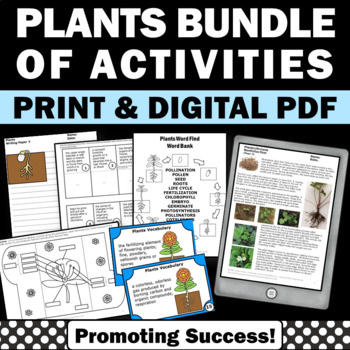Plant Life Cycle Activities & Projects for Kids

Before I begin, I want to share a couple cool plant videos.
How about a free plant life cycle word search before you continue reading? Click HERE.
Here are five ideas and projects to add to your plant unit activities:
1. Seed Sprout in a Jar
This one’s simple, easy, and kids love it! Grab a few clear jars, cotton balls or paper towels, and different types of seeds (bean seeds work great). Place the cotton or paper towel inside the jar, add a seed, and keep it moist. Then, have your students watch as the seed germinates and begins to sprout! They’ll get to see the roots and tiny shoots as they grow—an up-close look at the first stage of plant life that’s truly mesmerizing.
2. Create a Plant Life Cycle Wheel
A fun, creative project that also makes a great take-home display! Give students pre-cut circles, then let them divide each circle into four sections to represent the life stages of a plant: seed, sprout, seedling, and mature plant. They can color or draw each stage, add labels, and connect the pieces to create a turning wheel. The best part? They get a physical, hands-on way to see how plants grow and change over time.
3. Plant Observation Journals
If you’re doing any in-class planting, consider adding observation journals into the mix. Give each student a small notebook or worksheet where they can record their plant’s growth and changes. They can draw pictures of each stage, describe what they see, or even add in measurements if they’re watching something grow over time. This activity is perfect for practicing observation skills, while making science personal and exciting!
4. Sunflower Race Challenge
This one’s fun and friendly! Have each student plant a sunflower seed in small pots (or even recycled containers like yogurt cups) and place them in a sunny spot. Set up a class chart and let students track the growth of their sunflowers each week. Who will have the tallest sunflower? This friendly “race” helps reinforce the importance of sunlight and water while teaching the patience required to see plants grow over time.
5. Exploring Pollination with Pipe Cleaner “Bees”
Pollination is such a key part of the plant life cycle, but explaining it to young kids can sometimes be tricky. This hands-on activity makes it fun and memorable. Give each student a “bee”—a pipe cleaner twisted into a small bee shape—and then use powdered drink mix or even real flower pollen if you have some. Let the “bees” collect “pollen” from one flower (or paper flower) and “pollinate” another. They’ll get to see how bees and other pollinators are essential for plant life!
I hope these ideas inspire you and make learning about plants and their life cycles feel fun, approachable, and super hands-on for your young learners! Let me know which activities your students enjoy the most. 🌱








